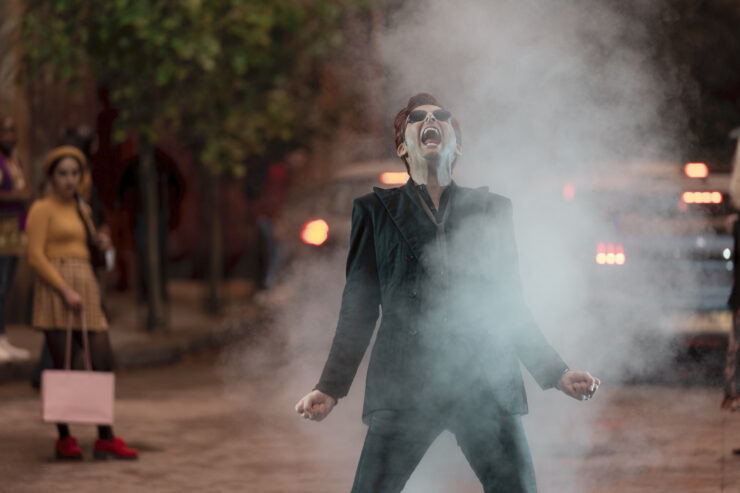When “Easter eggs” are done right, they can be so much fun. There were quite a few in the latest season of Good Omens, so I thought I’d compile all the ones I noticed. Like a scavenger hunt for your brain!
Obviously it’s possible that not all of these were intentional, but that’s part of what makes the hunt fun—not all references are conscious, and sometimes they’re even incidental. Dig in, folks!
[Some spoilers for Good Omens 2]
Dick-in-a-box
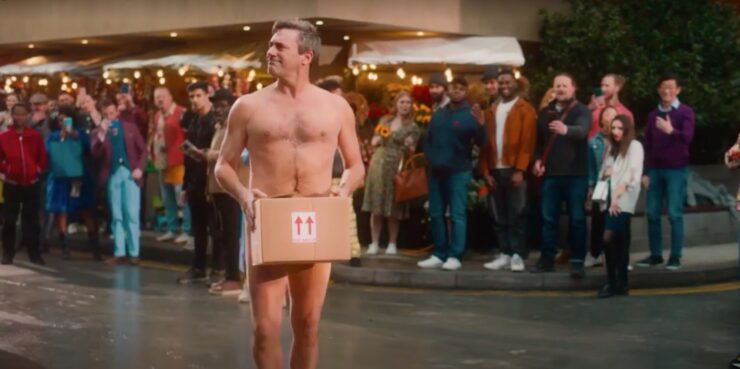
Look, jokes where a naked actor has various props placed strategically in front of their nether region to avoid a full-frontal rating is a hallmark of cinema silliness. (See: Austen Powers, et al.) But having Jon Hamm walk through a street in Soho with only a cardboard box preserving his modesty is automatically going to put folks in mind of the infamous Lonely Island SNL skit “Dick in a Box,” featuring Justin Timberlake. This is perhaps even a little funnier if you were a fan of the Good Omens book before the series—in the book it’s suggested that angels don’t have genitalia unless they “make an effort,” but Gabriel clearly does once the box is dropped, judging by public reaction. Poor Aziraphale. And no, we’ll be fielding no jokes about how it’s Jon Hamm, isn’t he dreamy, Aziraphale should be so lucky: That’s his former boss, y’all. No one deserves that.
Sherlock
There’s a point where Aziraphale is reminiscing about the events in the Book of Job, and when he comes back to himself, Gabriel has to tell him that Crowley departed while he was zoned out. This is almost identical to a scene in the BBC’s Sherlock when Irene Adler has to inform Sherlock that John Watson left their flat while he was deep in thought. (He does that a lot, you see. I imagine Aziraphale does, too, albeit in a kinder way.)
Doctor Who
There were plenty of references in the previous season, but season two ups the ante by having Peter Davison—the Fifth Doctor and David Tennant’s father-in-law—play the biblical figure Job. (Tennant’s son Ty also appears as his grandfather’s son, Ennon, making things that much more twisted.) And then there’s the fly that Beelzebub gives Gabriel, which is “bigger on the inside” like the TARDIS.
Tommy Cooper
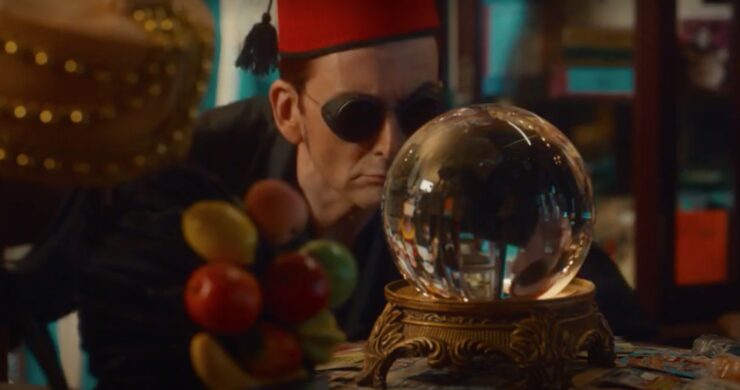
While it’s tempting to assume that Crowley donning a fez in the magic shop around the corner from Aziraphale’s bookshop is another Whovian reference—after all, in the words of the Eleventh Doctor, “fezzes are cool”—this is more likely a reference to the British comedian Tommy Cooper, who was known for wearing a fez while he entertained audiences with an act that was half stand-up, half slight-of-hand. Maybe Cooper got his signature fez from this very storefront; it’s been around long enough.
David Hasselhoff
Aziraphale’s book from magic tutor Mr. Hoffman is inscribed with a kind note and a signature reading “The Hoff.” But as we all know, the only person truly permitted to call themselves The Hoff is the one and only David Hasselhoff, of Knight Rider and Baywatch fame.
No Regerts
When Aziraphale is confronted in a Scottish graveyard by two would-be rough gentlemen, one of them is sporting a multitude of tattoos, including a forehead piece that replicates the viral internet sensation discovered in a compilation of tattoos with spelling errors—this one reading “NO REGERTS” in bold, black ink. It leaves one with many question, chief among them: Is this man the only person who sports the misspelling in the Good Omens universe? Or is this a deliberately referential tattoo, thereby belying a far more complex interior than this particular fellow is keen to put off in public?
Hot Fuzz
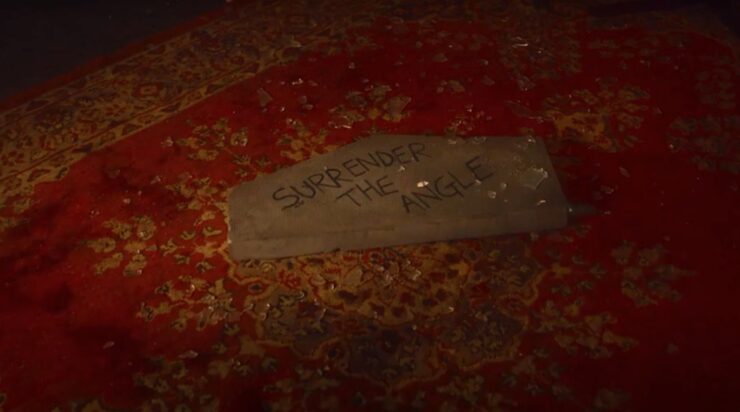
Misspellings always being good for comedy is also what leads the (terribly small) legion of demons commanded by Shax to throw a wood plank through Aziraphale’s bookshop window—demanding that he give up the “angle” Gabriel to the forces of Hell. But this particular mistake is a familiar one, put to use by a newspaperman known for typos in Hot Fuzz. Sergeant Nicholas Angel gets razzed by Sanford citizens and coworkers all day for that one.
Care to Explain That Suit?
This isn’t exactly an Easter egg, but I needed to point it out somewhere for my own sanity: Aziraphale prompts a few miraculous wardrobe changes for anyone who is not “appropriately” dressed for his Austen-ian ball in episode five, but there’s something funny happening with Gabriel. Namely, before the party ever occurs, he’s dressed in clothes that likely belong to Aziraphale himself: They’re all in his usual colors and styles, after all, and it would make sense to start handing “Jim” anything he had packed away once it became clear that he was going to be hanging around for a while…
…so we’re gonna have to talk about that bedazzled powder blue suit (and fluffy cloak), I think. Because, chances are, these are also sourced from Aziraphale’s old/unused clothing. I know he’s not one for bebop, so it’s unlikely that he kept it in storage from an Elton John concert. Maybe Aziraphale was subbing in for Liberace? I need to know.
Suzy Izzard
When the Metatron goes to get a coffee at Nina’s shop, he asks her if anyone ever asks for death—a reference to the name of the establishment: Give Me Coffee or Give Me Death! But it also puts one in mind of Suzy Izzard’s stand-up routine Dress to Kill, where she suggests that the Church of England might offer supplicants the option of “cake or death” being far less efficient than the Spanish Inquisition.
Book References
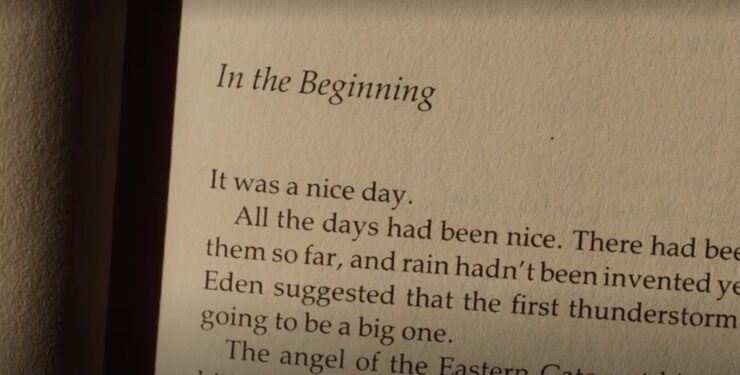
There are a few carefully placed callbacks to the Good Omens source material in season two, which are always fun to pick out…
- The Book Itself
As Gabriel is shelving books—alphabetically, by first word in first sentence—in Aziraphale’s shop, he comes across many-a-classic, including Jane Austen’s Pride and Prejudice, and Iain Banks’ The Crow Road. But he also comes across a book with the first line “It was a nice day.” This is, of course, the opening of Good Omens the novel. Hamm’s thoughtful, instinctually touched reading of the line is enough to make any fan a little teary.
- Bullet Hole Decals
They weren’t visible last season, but in season two, Crowley’s James Bond bullet-hole-through-the-windows decals can be plainly spotted on his beloved car. These are brought up rather pointedly in the book because Bond’s first car in the Fleming novels is a 1930 Blower Bentley, only a few years off from Crowley’s 1926 model, which seems to have tickled the demon a whole bunch. Because Crowley is supposed to project “cool,” but he’s really just a great big nerd. He had to buy petrol (a thing he never does) for the Bentley to get the decals and everything.
- How Exactly Do You Pronounce Aziraphale?
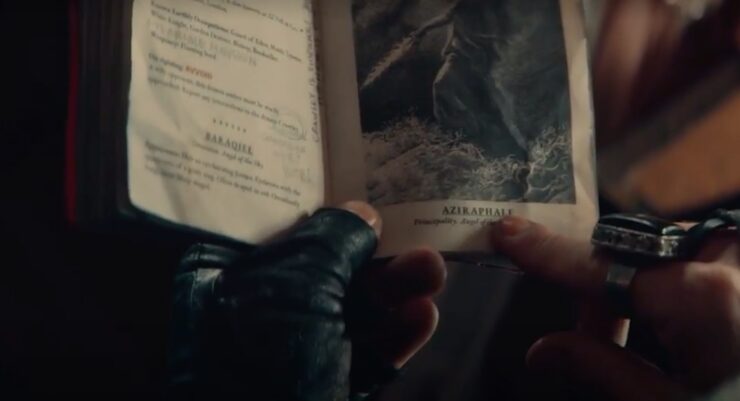
When the demon Furfur corners Aziraphale and Crowley about their collaboration in 1941 after setting a trio of Nazi zombies on their tail, he gloats to them both of his victory. Or, at least, he tries to: Crowley doesn’t seem to remember the guy he fought against heaven alongside, much to the underling’s dismay. He keeps trying, though, insisting that he knows all about Crowley’s little partnership with—he literally checks his notes—Azizaraph. Azirapapa. Azirpail.
This is a wink toward the fact that, until the series premiered, the pronunciation of Aziraphale’s name was one of the most prominent questions fans had for Terry Pratchett and Neil Gaiman. No joke, there was genuine discourse around this, discussion of angelic naming conventions and so forth. There was the suggestion that both authors had given different answers; that there had been one pronunciation decided upon beforehand, but that it didn’t seem to catch on, and the authors had given up. Even within the show there’s a bit of a discrepancy, with some characters pronouncing it “Azira-fell” versus “Azira-fail” (though that could largely be an accent issue, which is fascinating all by itself). Watching Furfur fumble over it several times was a nice little shoutout to those of us who have struggled with it for decades.
Discworld References
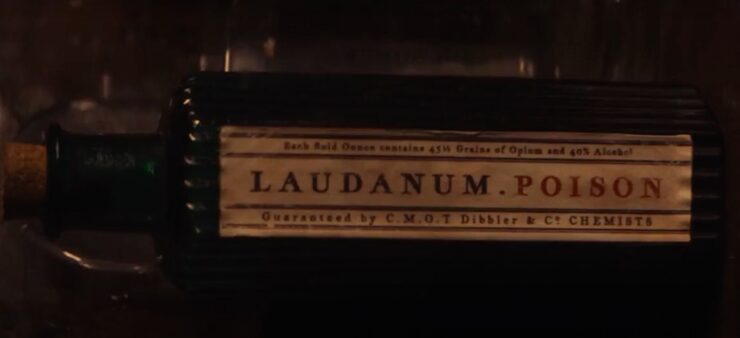
There are also several glaring references to Gaiman’s departed coauthor and dear friend, Terry Pratchett. And they’re all so good…
- “A Really —ing Terrible Idea”
It’s possible that this is just a coincidence of line reading, but when angel!Crowley notes that someone ought to be able to tell God when they’re making the wrong calls, he puts it as “Boss, this is a really —ing terrible idea.” Saying the ‘ing’ without the distinct curse attached was common of one Mr. Tulip, half of the New Firm found in the The Truth.
- Capital Letters
When Aziraphale excitedly tells Crowley that he’s committed to solving this Gabriel mystery and has even found a Clue, Crowley tells him knock it off and also “Don’t pronounce the capital letter.” This was, of course, a hallmark of Pratchett’s writing, who loved employing capital letters on words-of-import for the sake of emphasis and, of course, comedic effect. Many of Pratchett’s characters will comment about when they can “hear” the capital letters in someone else’s sentences, as Crowley is doing here.
- Dibbler’s Laudanum
In the flashback to 19th century Scotland, Crowley and Aziraphale meet a young bodysnatcher named Elspeth, whose fortunes take a turn for the worst when the angel’s meddling results in the need for another body to be snatched, inadvertently causing the death of her best friend. Determined to join said friend in the afterlife, Elspeth steals laudanum from Mr Dalrymple’s surgery, and the bottle bears the label “C.M.O.T. Dibbler & Co Chemists.”
Cut-Me-Own-Throat Dibbler is an Ankh-Morpork, er, businessman in the Discworld series, a purveyor of “fine” foods such a sausage inna bun, meat pies that might contain meat, and worse sausages inna bun. Dibbler never met a venture he wouldn’t happily try his hand at, and pops up doing everything from movie producing to tabloid journalism. (Vending poison just cuts out the middle man, you might say.) Throughout the books, Pratchett makes it clear that everyplace has their own version of Dibbler, which is why it makes perfect sense for him to show up here.
- Nac Mac Feegle
When Crowley decides to drink Dibbler’s laudanum himself in effort to save Elspeth, it has some unexpected side effects, one of which results in him shrinking, and also becoming a bit fighty and seemingly drunk. This makes him greatly resemble the Nac Mac Feegle, a race of fae creatures who are meant to be the Discworld version of Scottish folk (which Crowley is currently pretending to be and David Tennant is), who are all red-haired (check), incredibly small (currently check), and enamored of drinking and fighting (and check thanks to the laudanum). Granted, he promptly becomes very large after the fact, but the similarities can’t be discounted.
- Mrs. Sandwich
The owner of the brothel on Aziraphale’s street is one Mrs. Sandwich, which is a Pratchett-ish name if you’ve ever heard one. After all, the denizens of Ankh-Morpork certainly know to look out for Mrs. Cake.
- Seamstresses
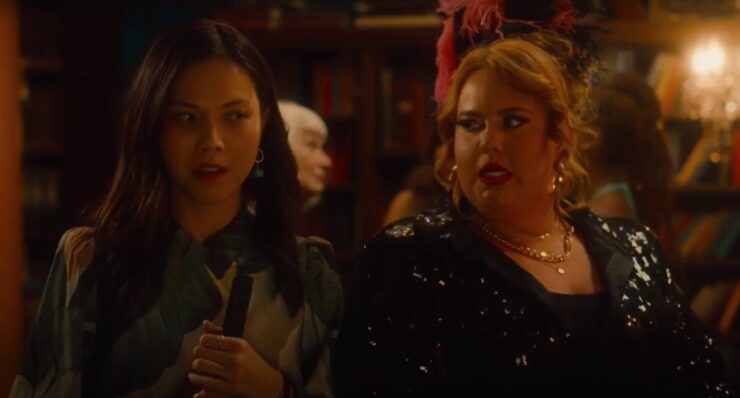
While at Aziraphale’s ball, everyone is charmed into using period-appropriate language and topics to suit the occasion. This leads to some confusion when Ms. Cheng asks Mrs. Sandwich what her business is, and Mrs. Sandwich finds that whenever she tries to answer, the response she gives is “seamstress.” She cannot say anything about the brothel, so she instead employs a handy metaphor to explain her work, all about darning socks and sewing on buttons for lonely men.
In the city of Ankh-Morpork the Seamstresses Guild happens to be the guild of sex workers. This leads to a fair amount of confusion for City Watch Commander Sam Vimes when he eventually meets a woman named Sandra, who actually is a seamstress within the guild—she winds up being helpful for the men who get (understandably) confused about the name, and do, in fact, turn up to have their shirts mended for a fee.
***
Those were all the ones I picked out of the lineup! How about you?
Emmet Asher-Perrin really needs to know when Aziraphale needed that blue suit, okay? You can bug them on Twitter and Bluesky, and read more of their work here and elsewhere.










